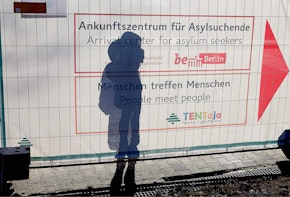As Egypt approaches the fifth anniversary of its 2011 uprising, one would be forgiven for assuming that a major challenge to the regime of President Abdel Fattah el-Sisi was gathering coherence and force, based upon its panicked and paranoid current actions. But such a conclusion would be misplaced. The regime’s overblown fears of a largely neutered opposition raise a pertinent question: What is driving the Egyptian security establishment’s overbroad and suffocating repression?
The run-up to January 25 has seen a major crackdown that has included arrests, disappearances, random searches (including random surveillance of social media accounts1), the shuttering of nonpolitical cultural fora, such as art galleries, and a heightening of visa monitoring for foreigners. For this upcoming symbolic date, the regime will not be caught unaware and flat-footed—it believes that the mistakes of 2011 will not be repeated any time soon.
Speaking to Reuters, an official at Egypt’s Homeland Security Agency explained the state’s motivations for the crackdown quite bluntly, stating that “We have taken several measures to ensure activists don’t have breathing space and are unable to gather, and several cafes and other meeting places have been closed, while some have been arrested in order to scare the rest.”2
Whereas late 2010 was marked by creeping dissatisfaction, increasing boldness, and stepped-up organizational efforts among opposition actors, there are no corollaries in today’s Egypt. While the government continues to fare poorly in terms of overall performance, political life is stunted by fear and fragmentation, and there are few avenues that allow for the amplification of dissatisfaction into a broad-based challenge to the regime. Opposition forces are fragmented and intimidated, while the regime, the state, and social elites retain a baseline of cohesion, and domestic and regional instability have produced quiescence in some sectors of society.
It is clear that 2016 will not be the year of the next Egyptian uprising, let alone revolution. Yet, despite indications that, for the time being, the regime is safe from any popular threat, it is behaving as if it faces an imminent challenge. Its actions reveal a deeply ingrained worldview in which even minor forms of dissent and nonconformity are no longer permissible.
An Under-Performing and Still-Consolidating Regime
Following the ouster of Muslim Brotherhood president Mohamed Morsi, the Sisi regime inherited a daunting set of political, economic, and security challenges. In this environment, the regime has not performed well, hindered by inexperience, a lack of vision, and the primacy of its concentration on the security sphere.
Despite the huge openings afforded by the post-Mubarak transition, the political turmoil, instability, violence, and repression of the transitional period have retarded the maturation of political life and atomized the political class. Some of this political stasis is by design, and is seen by the regime as a pathway to producing quiescent, dependent, and malleable political allies beyond the state. This can clearly be seen in the circuitous and drawn out efforts to produce an acceptable parliamentary outcome. The lack of coherent and robust political parties has made the prospect of organizing political life, even within controlled boundaries, more ad hoc and time-intensive.
The regime’s efforts to defang the political class, however, will create other problems, and over time may not be wholly successful in its chief aim of producing orderly and wholly predictable politics. Operationally, weakening political life in Egypt in effect produces a weak “political infrastructure” that will be ineffective in advancing any state initiatives. Without this larger network of effective allies, governance has remained, and will remain, an incredibly narrow endeavor, the purview of the president and the small opaque group of advisors surrounding him. As a result, any failures of governance will not be perceived as shared by the larger political class, but rather focused on Sisi himself.
Nowhere is the need for better governance more evident than the floundering Egyptian economy. The economic situation inherited by the Sisi regime was difficult, and Egypt still will need years to recover from recent setbacks. Since the uprisings of 2011, political instability and escalating violence have undermined Egyptian economic growth, crippled the country’s outsized tourism sector, and hindered foreign direct investment. As Amr Adly notes, this has meant that Egypt has been “dependent on massive capital inflows in the form of aid and cheap credit from the Gulf countries to fill the ever-widening financial gap.”3
The inflow resulting from this approach has been insufficient in and of itself to overcome the negative impact of regional and international economic turbulence and poor economic decision-making. The Sisi regime’s initial plans to ease budgetary woes through subsidy reforms have stalled, and the grand project-based approach to economic stimulus has lacked depth and planning. The end result is that, despite economic stabilization following the ouster of Morsi and the election of Sisi, security risks and a lack of consistency and predictability in policy planning continue to bedevil Egypt’s economy. As Adly notes, “in the medium term, Egypt needs to address its more structural problems and go beyond mere crisis-management.”4 To date, that has been impossible, not only due to exogenous factors, but also the current limitations of governance: the Sisi regime lacks economic vision, and the state and the political class are not in a position to initiate such structural reforms.
To be fair, not all of the state’s fears are imagined, and some, particularly with respect to terrorism and anti-state violence, are rooted in genuine threats. The security situation has posed a major challenge to current efforts at consolidation and normalization, exacerbated by regime strategy and tactics in both the political and security sectors. As Mokhtar Awad has argued, “Egypt is facing what is shaping up to be the deadliest and most complex insurgency in its modern history.”5 Awad has divided this insurgent threat into three broad categories:
Sinai-based jihadists affiliated with the self-proclaimed Islamic State and with a limited operational presence in the mainland (the populous heartland of Egypt along the Nile valley), mainland-based Salafi jihadists who tend to be supporters of al-Qaeda or affiliated with al-Qaeda, and a new category of non-Salafi-jihadi groups made up of Islamist supporters and some members of the Muslim Brotherhood.6
To this assessment one could also add the threats posed by the chaos in neighboring Libya and the increased jihadi penetration in that country.
These cumulative security threats had gathered pace following the ouster of Morsi, and the sophistication, tempo, and scope of attacks had continued to increase, particularly in the first half of 2015.7 However, since that time—and despite what is assumed to be the most high-profile terrorist attack in recent years, the alleged November 2015 downing of a Russian charter jet departing from Sharm el-Sheikh—security trends have stabilized, and there appears to be a generalized leveling of security incidents.8
Whether such levels are sustainable over time remains an open question, particularly as the regime’s counterinsurgency practices, in both the realm of politics and security, have often exacerbated underlying trends. Recent events suggest the existence of an intractable, resilient, and persistent insurgent and terrorist threat, but one that does not yet pose a systemic challenge to the state, particularly as attrition levels have decreased. This is most noticeable in mainland Egypt, where the tempo and scope of attacks have recently lessened. While the Sinai has proven much more volatile, the spillover into mainland Egypt and the country’s major population centers has remained fairly limited. In this sense, the security situation, at current rates of violence, remains a profoundly negative but manageable threat. And Egypt’s disastrous experience with domestic jihadism and insurgency in the 1990s also seems to be inhibiting the rise of the more indiscriminate forms of terrorism that have plagued portions of the Arab world in recent years.
In addition to and exacerbated by these factors, the Sisi regime itself remains stuck in the mode of consolidation, not having stamped its full authority over the state and its bureaucratic organs. The challenging process of reconstituting and managing an Egyptian state that had decayed prior to the uprising and had been further damaged by the uprising and the indeterminate drift of the immediate post-Mubarak years remains ongoing and unfinished.
Is Instability Still Sustainable?
Egypt’s present condition is bleak and troubling, with little to encourage any form of optimism. But structural conditions within the country and the broader regional environment continue to suggest that Egypt’s instability remains sustainable.
Despite the security establishment’s fears that the tactical alliances that propelled the January 25 uprising may be reprised, there is no real sign that the existing rift that between the Islamist and non-Islamist camps will be mended in the near-to-medium future. In this sense political fragmentation within and among opposition and potential opposition forces endures.
In the face of severe regime repression and pressure, the Muslim Brotherhood itself has also fragmented and no longer appears to function as a coherent whole. The group was legally designated as a terrorist entity, and mere membership has become dangerous and prosecutable. The Brotherhood now lacks the capacity to mobilize and sustain major public protests. Most of the Brotherhood’s most recognized and senior leaders are now imprisoned or in exile. These circumstances have made centralized decision-making near impossible. However, the prospect of localized autonomy has created major challenges for an organization accustomed to rigid hierarchy and zealously committed to the maintenance of organizational coherence. In the face of radicalizing cadres, this has forced much of the leadership into a muddled compromise on the issue of violence as an acceptable tool to achieve political aims. These strains now jeopardize the Brotherhood’s organizational structures and ideology. The end result of the Brotherhood’s gamble to force a frontal confrontation with the state in June 2013 appears to be a serious breakdown in the Brotherhood’s organizational integrity. This fragmentation and radicalization of segments of the Brotherhood boosts hardline views within the state’s security establishment about the future of the group, and makes the prospect of any kind of rapprochement among opposition forces even less likely.
The success of the 2011 uprising was predicated on the short-lived but potent form of tactical alliance among the broad spectrum of opposition actors and organizations, which produced fleeting opposition solidarity against a crumbling regime. Mubarak’s fall could not have happened without the collapse of the police and the eventual neutrality of the military, which envisioned a beneficial future for both the institution of the armed forces and the Egyptian state that was not tethered to the immediate fate of Mubarak. While internal competition and disputes within the regime have only intensified and sharpened since the chaotic and threatening period immediately following the military’s July 2013 ouster of Morsi, the regime and the state show no signs of imminent ruptures or rifts that could threaten overall stability. Similarly, elite cohesion endures, despite increased frustrations with the Sisi regime and the country’s trajectory. This uneasy cohesion rests not upon deep-rooted support for Sisi and his leadership—although Sisi does enjoy durable sources of support—but rather stems from a sense of collective threat born of the fears of downside risks. The near-collapse in 2011 of the web of power and influence of traditional elites and the security state has bred a renewed determination to maintain their dominant position and to not allow internal competition and divides to reach a level that could expose the regime and the state to serious external threat.
Furthermore, the pathways to bottom-up change remain distant. The boldness to challenge the state that gathered momentum over the decade prior to 2011 has understandably receded in the face of the regime’s unmitigated repression. That repression has stunted political life and aggravated underlying militant trends, but it has undeniably been successful in intimidating political actors and chilling the possibility for mass mobilization and protest. More broadly, and despite increasingly challenging economic conditions, Egyptian society remains fearful and fatigued, both by the tumultuous period of failed transition and by the negative regional examples of state failure and collapse.
The overall picture for the foreseeable future is one of generalized dissatisfaction without a channel or vehicle to translate such sentiments into broad-based political form or action.
Parsing Motivations
In this light, the initial question remains: In the face of inchoate and manageable threats, why does the Egyptian regime betray a sense of panic and fear?
When seeking answers to this question, it is important to note the balkanized nature of the state and the initiative, often negative, demonstrated by individual and institutional actors. It is often a mistake to impute collective intent when viewing these actions taken in the name of the state. However, it also would be faulty to understand this escalating crackdown as a wholly uncoordinated effort.
There are several plausible explanations as to why the regime is going to such lengths to repress any and all forms of existing and potential dissent. First, this repression can be seen as a preemptive approach to counter any gathering threats, based on the assumption of future and growing vulnerabilities. In the late Mubarak era, certain forms of political organizing and dissent were allowed room to operate in what was then perceived to be a controlled political environment. While repression was often ferocious, its targets were selective. This approach created a safety valve of sorts for the Mubarak regime, but it also eventually allowed a vibrant opposition community to grow and expand, producing a critical mass that came to the streets in January 2011. Such efforts will no longer be tolerated.
Second, since the ouster of Morsi, the security establishment has been motivated in part by its sense of grievance and revenge, stemming from the humiliations of the 2011 uprising and the collapse of the police. The unchecked impulses of an ascendant security establishment have produced an institution bent on quashing any forms of dissent. In this sense, the reimposition of order is understood to be predicated upon the reforming of previously existing and rigid hierarchies between police and civilians and between elders and youth.
Relatedly, the security establishment clearly believes in the efficacy of repression and fear as tools to produce acceptable outcomes: order, stability, and a quiescent political class and citizenry.
Finally, and perhaps most importantly, the current regime is a paranoid regime that believes many of the conspiracy theories it peddles, producing irrational responses. It is often assumed that the conspiracy-addled narratives offered by state media and encouraged by the security establishment are a cynical ploy to redirect anger and buttress regime support. But such assumptions are often mistaken.
Based on numerous interactions with members of the security establishment, it is abundantly clear that many within the Egyptian regime have deeply held and outlandish beliefs in conspiracy theories about the myriad threats facing Egypt. Of course, as discussed above, Egypt does face significant threats, but often the focus on the implausible and the imaginary diverts precious attention away from existing reality. Speaking to Buzzfeed, Ramy Raoof, an Egyptian digital security expert, suggested that the random searches of social media accounts were an attempt to ascertain atmospherics ahead of January 25, without the burdens imposed by more traditional forms of surveillance.9 In essence, such maneuvers can be seen as a crude form of dragnet: attempts to locate and foil impending plots, plots that many in the regime assume are already in place.
It is perhaps ironic that the outcome of such escalating repression is to produce an external image of a beleaguered regime operating under the threat of imminent challenges to its continued rule. The Sisi regime has on its own managed to cultivate an image of weakness for itself that its opponents could not even dream of producing.
Notes
-
1. Maged Atef, “Egyptian Police Are Performing Random Facebook Checks Ahead of Revolution Anniversary,” Buzzfeed, January 20, 2016, http://www.buzzfeed.com/magedatef/egyptian-police-are-performing-random-facebook-checks-ahead.
2. Ahmed Aboulenein, “Egypt: Who’s Afraid of January 25th?” Reuters, January 20, 2016, http://www.reuters.com/article/us-egypt-crackdown-idUSKCN0UY169.
3. Amr Adly, “Egypt Economy ‘Entered a Vicious Circle,’”’ al-Jazeera, December 10, 2015, http://www.aljazeera.com/news/2015/12/analysis-egypt-economy-entered-vicious-circle-151203112708562.html.
4. Ibid.
5. Mokhtar Awad, “Egypt’s Escalating Islamist Insurgency,” Carnegie Middle East Center, October 2015, http://carnegieendowment.org/files/CMEC_58_Egypt_Awad_Hashem_final.pdf.
6. Ibid.
7. The Regional Center for Strategic Studies, “Cairo Index: Measuring Violence in Egypt,” January 17, 2016, http://www.rcssmideast.org/en/Article/10602/Cairo-Index-Measuring-Violence-in-Egypt#.VqAiCogrKUl.
8. Although there are no current cumulative figures for recent months, anecdotal accounts and monitoring of both press and governmental sources suggest that the tempo of terrorism and anti-state violence has slowed in recent months.
9. Atef, “Egyptian Police Are Performing Random Facebook Checks Ahead of Revolution Anniversary.”









